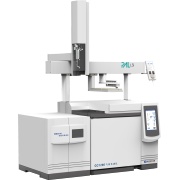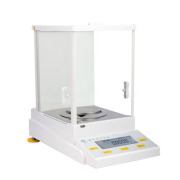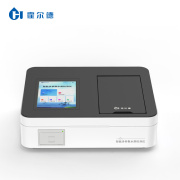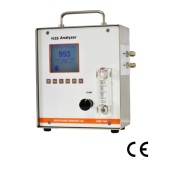采用特殊的微电子处理器,能够识别在空气或固体中传播的微小震动,适合搜寻被困在混凝土、瓦砾或
其他固体下的幸存者,能准确识别来自幸存者的声音如呼喊、拍打、刻划或敲击等。与此同时,还可以将周
围的背景噪音做过滤处理。
全方位音频传感器,探测频率:1~3000Hz
可同时接收2个传感器信息,可同时波谱显示任意两个传感器信息
配备小型对讲机,能同幸存者对话
佩带式耳机0.13W/60Ω
6节1号充电电池,可工作24小时
外接直流输入:10.8-28.8V
储存温度:-40-70度
工作温度:-30-60度
The LifeDetector Model 80M287612 is designed to detect and locate signs of a
victim’s presence in the voids of a collapsed building or similar entrapment situation using seismic and/or acoustic sensors. The 80M287612 is equipped with two separate sensor systems to detect and locate
victims. The seismic sensor detects sound vibrations generated by a victim’s
movement or activity traveling through the structural members of the building. The
acoustic sensor detects sound vibrations traveling through the surrounding airspace.
The 80M287612 Display Interface (DI) allows an operator to listen to and review
the relative response of up to two seismic sensors or two acoustic sensors. The
80M287612 displays each sensor’s response on the display graph simultaneously for
easy comparison and to provide continuous feedback of the victim’s response. The
acoustic sensors allow two-way communication with the victim using an integrated intercom system.
The 80M287612 comes standard for use with disposable Lithium Ion batteries only.
However, Rechargeable Lithium Ion batteries as well as a charger and power supply
are available as an option.
Case Layout
The case is designed to house all of the 80M287612 standard equipment. The following
drawing shows 80M287612 component location within the case.
Optional Items
Telescoping Probe (for use with acoustic sensors) - This rigid probe allows the
operator to attach an acoustic sensor to its end providing the ability to push the
sensor into a crevasse or hole with a diameter as small as two inches (5 cm).
The telescoping probe allows the operator to place the sensor into the lower
layers of a collapsed structure by extending the probe as needed.
Rigid Threaded Tube (for use with acoustic sensors) - The rigid threaded tubes
come in fixed length sections. An acoustic sensor attaches to one end. A single
tube can be used or additional tubes that extend the reach of the acoustic probe
can be added.
Replacement Sensors - The 80M287612 supports up to two seismic sensors or
two acoustic sensors.
Replacement 3 or 10 Meter Cables
All other components such as spikes, magnetic clamps, and batteries are also available.
80M287612 Display Interface
The Display Interface (DI) is the main control center for the 80M287612. The DI controls
each sensor and displays the sensor’s responses on the bar graph while routing the
signals to the headphones for listening.
The numbered sensor selection keys control which sensors are listened to in the
headphones. Each numbered key corresponds to a numbered sensor. The LED in the upper-left corner of the key indicates that the sensor channel audio is selected for listening.
Sensor Selection Keys 1 and 2 are also used when the acoustic sensors are connected. If
an acoustic sensor is connected, the LED in the lower-right corner of the key is illuminated.
The Amplitude Graph LED bars indicate the response level of each sensor and correspond to the Sensor Channel Keys located above each bar.
The L-R headphone key activates the stereo feature allowing the operator to listen to one sensor in one ear and another sensor in the other.
The low and high filter keys control the signal filters. These filters can be used to reduce the effects of certain types of noises that can interfere with listening to the seismic sensors.
The LOW key activates a low-frequency cut filter that reduces signal frequencies that are below 200 Hz. The HIGH key activates a high-frequency filter that reduces signal frequencies that are above 1000 Hz. This filter reduces background noise like “hiss”.
The Zoom key changes the resolution of the bar graph to better differentiate the signals in high signal level conditions. These conditions usually occur when the sensors are close to each other during the victim location mode.
Zoom mode makes comparison between sensors easier.
技术参数:
采用特殊的微电子处理器,能够识别在空气或固体中传播的微小震动,适合搜寻被困在混凝土、瓦砾或
其他固体下的幸存者,能准确识别来自幸存者的声音如呼喊、拍打、刻划或敲击等。与此同时,还可以将周
围的背景噪音做过滤处理。
全方位音频传感器,探测频率:1~3000Hz
可同时接收2个传感器信息,可同时波谱显示任意两个传感器信息
配备小型对讲机,能同幸存者对话
佩带式耳机0.13W/60Ω
6节1号充电电池,可工作24小时
外接直流输入:10.8-28.8V
储存温度:-40-70度
工作温度:-30-60度
The LifeDetector Model 80M287612 is designed to detect and locate signs of a
victim’s presence in the voids of a collapsed building or similar entrapment situation using seismic and/or acoustic sensors. The 80M287612 is equipped with two separate sensor systems to detect and locate
victims. The seismic sensor detects sound vibrations generated by a victim’s
movement or activity traveling through the structural members of the building. The
acoustic sensor detects sound vibrations traveling through the surrounding airspace.
The 80M287612 Display Interface (DI) allows an operator to listen to and review
the relative response of up to two seismic sensors or two acoustic sensors. The
80M287612 displays each sensor’s response on the display graph simultaneously for
easy comparison and to provide continuous feedback of the victim’s response. The
acoustic sensors allow two-way communication with the victim using an integrated intercom system.
The 80M287612 comes standard for use with disposable Lithium Ion batteries only.
However, Rechargeable Lithium Ion batteries as well as a charger and power supply
are available as an option.
Case Layout
The case is designed to house all of the 80M287612 standard equipment. The following
drawing shows 80M287612 component location within the case.
Optional Items
Telescoping Probe (for use with acoustic sensors) - This rigid probe allows the
operator to attach an acoustic sensor to its end providing the ability to push the
sensor into a crevasse or hole with a diameter as small as two inches (5 cm).
The telescoping probe allows the operator to place the sensor into the lower
layers of a collapsed structure by extending the probe as needed.
Rigid Threaded Tube (for use with acoustic sensors) - The rigid threaded tubes
come in fixed length sections. An acoustic sensor attaches to one end. A single
tube can be used or additional tubes that extend the reach of the acoustic probe
can be added.
Replacement Sensors - The 80M287612 supports up to two seismic sensors or
two acoustic sensors.
Replacement 3 or 10 Meter Cables
All other components such as spikes, magnetic clamps, and batteries are also available.
80M287612 Display Interface
The Display Interface (DI) is the main control center for the 80M287612. The DI controls
each sensor and displays the sensor’s responses on the bar graph while routing the
signals to the headphones for listening.
The numbered sensor selection keys control which sensors are listened to in the
headphones. Each numbered key corresponds to a numbered sensor. The LED in the upper-left corner of the key indicates that the sensor channel audio is selected for listening.
Sensor Selection Keys 1 and 2 are also used when the acoustic sensors are connected. If
an acoustic sensor is connected, the LED in the lower-right corner of the key is illuminated.
The Amplitude Graph LED bars indicate the response level of each sensor and correspond to the Sensor Channel Keys located above each bar.
The L-R headphone key activates the stereo feature allowing the operator to listen to one sensor in one ear and another sensor in the other.
The low and high filter keys control the signal filters. These filters can be used to reduce the effects of certain types of noises that can interfere with listening to the seismic sensors.
The LOW key activates a low-frequency cut filter that reduces signal frequencies that are below 200 Hz. The HIGH key activates a high-frequency filter that reduces signal frequencies that are above 1000 Hz. This filter reduces background noise like “hiss”.
The Zoom key changes the resolution of the bar graph to better differentiate the signals in high signal level conditions. These conditions usually occur when the sensors are close to each other during the victim location mode.
Zoom mode makes comparison between sensors easier.
主要特点:
采用特殊的微电子处理器,能够识别在空气或固体中传播的微小震动,适合搜寻被困在混凝土、瓦砾或
其他固体下的幸存者,能准确识别来自幸存者的声音如呼喊、拍打、刻划或敲击等。与此同时,还可以将周
围的背景噪音做过滤处理。
全方位音频传感器,探测频率:1~3000Hz
可同时接收2个传感器信息,可同时波谱显示任意两个传感器信息
配备小型对讲机,能同幸存者对话
佩带式耳机0.13W/60Ω
6节1号充电电池,可工作24小时
外接直流输入:10.8-28.8V
储存温度:-40-70度
工作温度:-30-60度
The LifeDetector Model 80M287612 is designed to detect and locate signs of a
victim’s presence in the voids of a collapsed building or similar entrapment situation using seismic and/or acoustic sensors. The 80M287612 is equipped with two separate sensor systems to detect and locate
victims. The seismic sensor detects sound vibrations generated by a victim’s
movement or activity traveling through the structural members of the building. The
acoustic sensor detects sound vibrations traveling through the surrounding airspace.
The 80M287612 Display Interface (DI) allows an operator to listen to and review
the relative response of up to two seismic sensors or two acoustic sensors. The
80M287612 displays each sensor’s response on the display graph simultaneously for
easy comparison and to provide continuous feedback of the victim’s response. The
acoustic sensors allow two-way communication with the victim using an integrated intercom system.
The 80M287612 comes standard for use with disposable Lithium Ion batteries only.
However, Rechargeable Lithium Ion batteries as well as a charger and power supply
are available as an option.
Case Layout
The case is designed to house all of the 80M287612 standard equipment. The following
drawing shows 80M287612 component location within the case.
Optional Items
Telescoping Probe (for use with acoustic sensors) - This rigid probe allows the
operator to attach an acoustic sensor to its end providing the ability to push the
sensor into a crevasse or hole with a diameter as small as two inches (5 cm).
The telescoping probe allows the operator to place the sensor into the lower
layers of a collapsed structure by extending the probe as needed.
Rigid Threaded Tube (for use with acoustic sensors) - The rigid threaded tubes
come in fixed length sections. An acoustic sensor attaches to one end. A single
tube can be used or additional tubes that extend the reach of the acoustic probe
can be added.
Replacement Sensors - The 80M287612 supports up to two seismic sensors or
two acoustic sensors.
Replacement 3 or 10 Meter Cables
All other components such as spikes, magnetic clamps, and batteries are also available.
80M287612 Display Interface
The Display Interface (DI) is the main control center for the 80M287612. The DI controls
each sensor and displays the sensor’s responses on the bar graph while routing the
signals to the headphones for listening.
The numbered sensor selection keys control which sensors are listened to in the
headphones. Each numbered key corresponds to a numbered sensor. The LED in the upper-left corner of the key indicates that the sensor channel audio is selected for listening.
Sensor Selection Keys 1 and 2 are also used when the acoustic sensors are connected. If
an acoustic sensor is connected, the LED in the lower-right corner of the key is illuminated.
The Amplitude Graph LED bars indicate the response level of each sensor and correspond to the Sensor Channel Keys located above each bar.
The L-R headphone key activates the stereo feature allowing the operator to listen to one sensor in one ear and another sensor in the other.
The low and high filter keys control the signal filters. These filters can be used to reduce the effects of certain types of noises that can interfere with listening to the seismic sensors.
The LOW key activates a low-frequency cut filter that reduces signal frequencies that are below 200 Hz. The HIGH key activates a high-frequency filter that reduces signal frequencies that are above 1000 Hz. This filter reduces background noise like “hiss”.
The Zoom key changes the resolution of the bar graph to better differentiate the signals in high signal level conditions. These conditions usually occur when the sensors are close to each other during the victim location mode.
Zoom mode makes comparison between sensors easier.
相关产品



 仪器对比
仪器对比



 关注
关注







